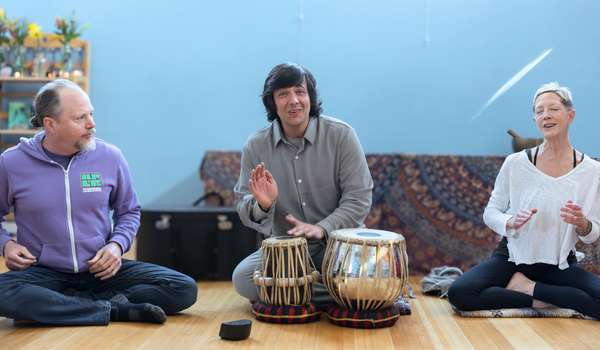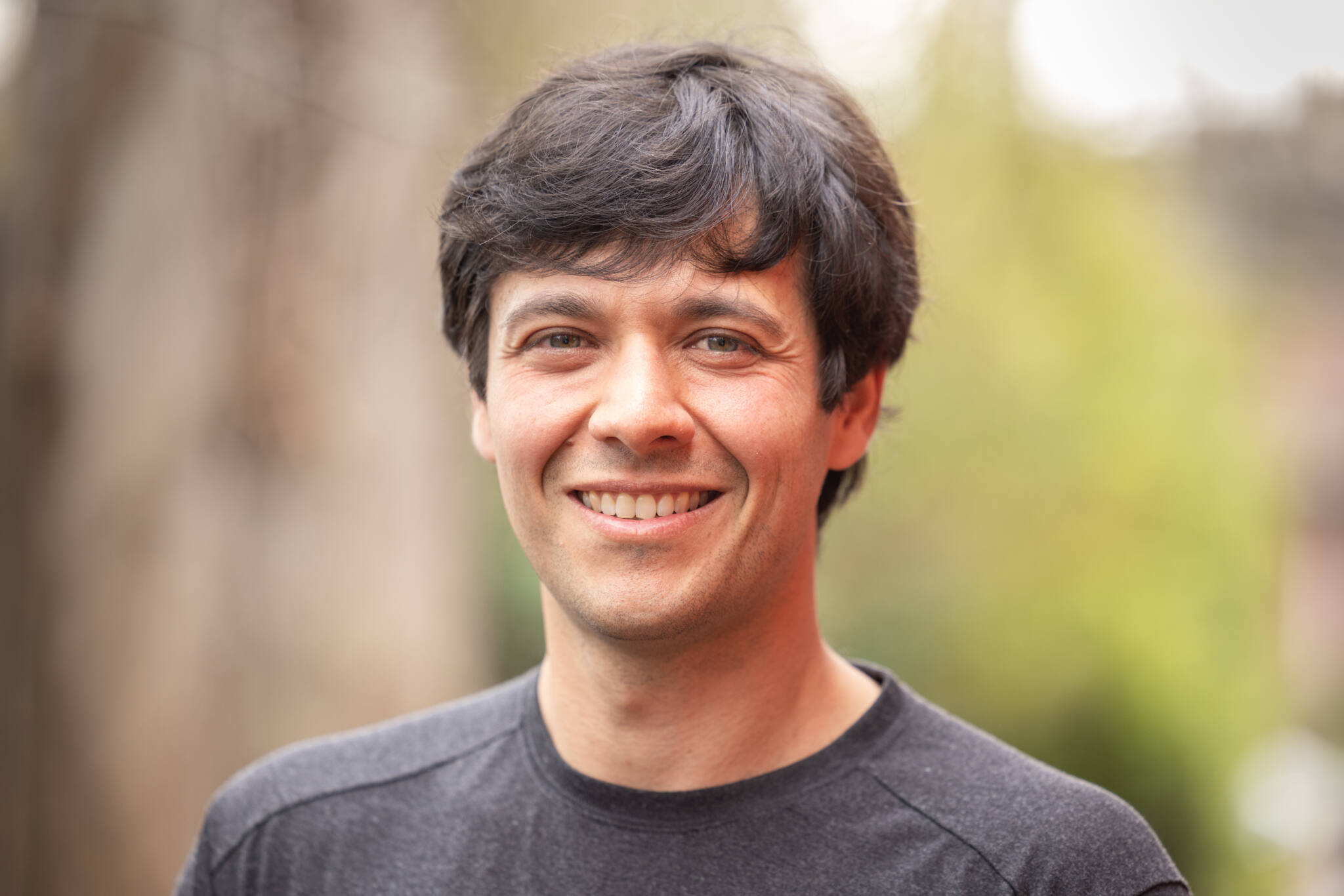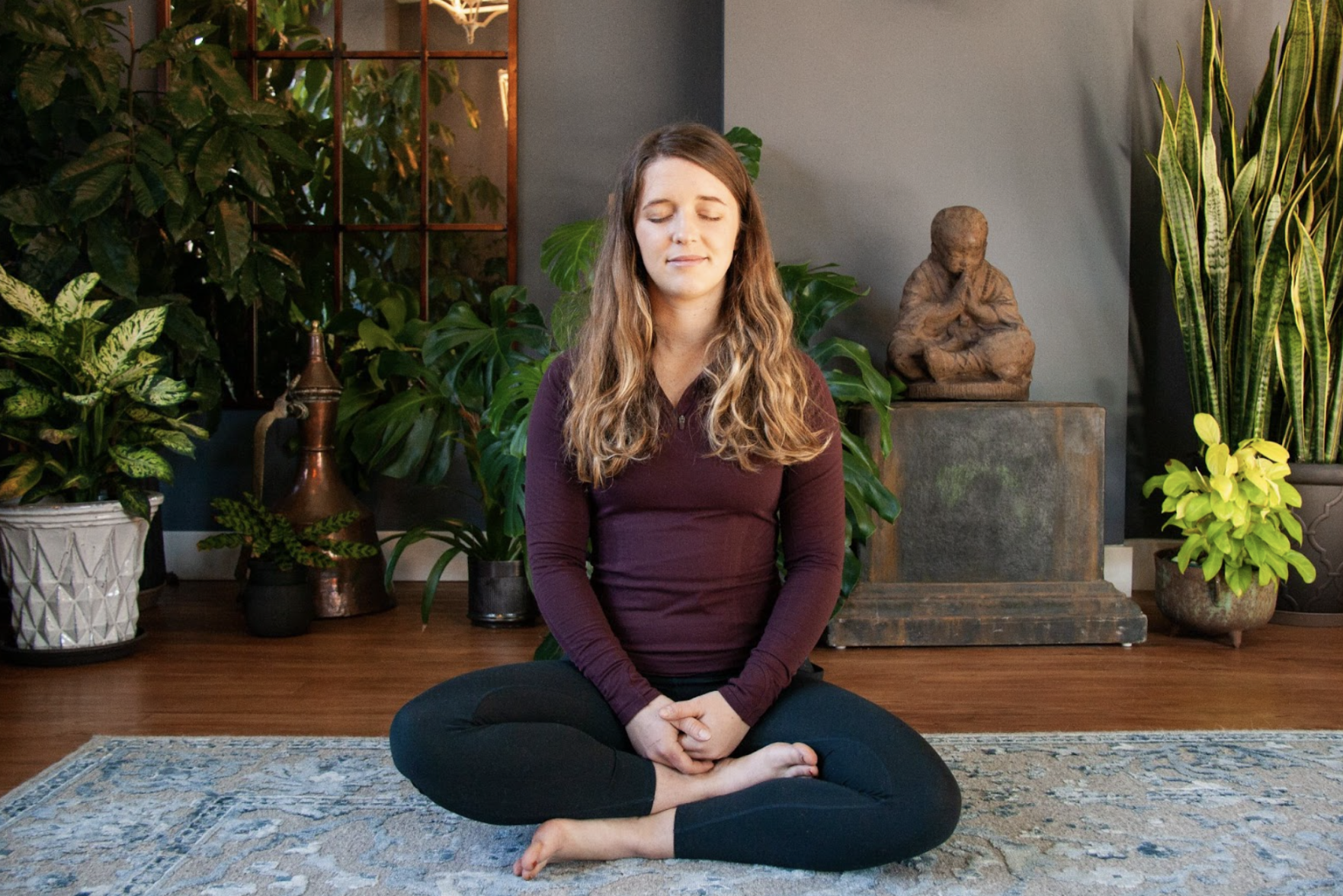
Key Takeaways:
Kirtan is a form of devotional chanting rooted in Bhakti yoga, offering a way to connect deeply with others and the divine through shared sound and melody.
Originating in ancient India, kirtan spread to the West in the 1960s, becoming a bridge across cultures and a communal practice that welcomes everyone.
- At Asheville Yoga Center, kirtan is a regular practice that fosters community and personal transformation, inviting all to join in regardless of experience
Kirtan in Asheville: A Beginner’s Guide to Yoga’s Sacred Sound Practice
If you’ve strolled through Asheville’s lively streets, you’ve probably heard the inviting rhythms of kirtan—joyful group chanting tied to yoga tradition. But what exactly is kirtan? Simply put, it’s a musical, communal mantra practice that anyone can join—no singing experience or yoga expertise needed!
At Asheville Yoga Center, we’ve been nurturing community and sharing the heart of yoga since 1997. Our kirtan gatherings are all about connection—people from all backgrounds coming together to chant, sing, and feel the energy of sacred sound. There’s no pressure to perform. You just show up, immerse yourself in the music, and let it bring you a sense of peace and belonging.
Whether you’re local or just visiting, we welcome you to experience the power of kirtan with us. Step into the circle, open your heart, and discover how this ancient practice can ground and uplift you at the same time.
What Is Kirtan?
Let’s get to the heart of it: kirtan is one of yoga’s most sacred sound practices, a call-and-response style of devotional chanting rooted in ancient Indian traditions. It’s not just singing for the sake of singing—it’s a meditative journey, a way to connect with something bigger than yourself, whether you call that spirit, community, or simply the hum of the universe. Picture a room full of people of every walk of life, voices weaving together, repeating mantras in Sanskrit or other sacred languages, often accompanied by instruments like the harmonium, tabla, or guitar. The melodies are simple, repetitive, almost hypnotic, designed to pull you out of your head and into the moment. Here, there is no judgement, only openness and acceptance of every participant.
At its core, kirtan is a bhakti yoga practice—the path of devotion. It’s less about hitting the right notes and more about opening your heart fully. You don’t need to be a musician or even understand the words to feel the vibration of a chant like “Om Namah Shivaya” ripple through you. Historically, kirtan has been a communal practice for centuries, a way for people to gather, shed their egos, and tap into a shared energy. It’s raw, unpolished, and deeply human—think less polished choir and more soulful campfire singalong. Whether you’re chanting to a deity, to nature, or just to the feeling of connection, kirtan invites everyone to the table, no experience required.
The Meaning of Kirtan in Yoga Tradition
Rooted in Bhakti tradition—kirtan reflects the path of love and devotion. The word comes from Sanskrit and means to praise or glorify. In practice, kirtan is a group call-and-response singing of mantras, often in Sanskrit, accompanied by instruments like the harmonium or drums. It’s less about performance and more about connecting, both with yourself and a sense of something bigger—be it the divine, the universe, or community energy.
Dating back centuries to India’s Bhakti movement, kirtan uses simple sacred phrases like Om Namah Shivaya or Hare Krishna to quiet the mind and open the heart. You don’t need to understand the words to feel their effect—kirtan is about vibration and intention, not language. As part of yoga, kirtan bridges personal practice with shared experience, reminding us that yoga is as much about community and heart as it is about body and mind.
Why Kirtan Is Called “Yoga of Sound”
Kirtan is called the “yoga of sound” because it uses chanting and music to create a sense of unity and presence, much like yoga unites mind and body. Rather than focusing on perfect singing, participants chant sacred names and mantras—often in a call-and-response style—to tap into deeper states of meditation and connection.
The sound and repetition themselves quiet the mind and foster a collective energy. In kirtan, your own voice becomes an instrument of connection, making it a form of yoga—one that happens through sound rather than posture.
The Roots of Kirtan
Let’s take a step back to the dusty, vibrant landscapes of India, where the seeds of kirtan were first sown. Picture this: hundreds of years ago, in the heart of villages, people gathered under trees, in humble temples, or in their own homes, their voices rising together in devotion. Kirtan, at its core, is a call-and-response form of chanting, rooted in the ancient mantras and sonic practices of India, with a simple emphasis on love about love and surrender to the divine. It’s a raw, unfiltered connection to something bigger, whether you call that God, the universe, or simply the shared energy of the people around you.
The word “kirtan” itself comes from the Sanskrit root “kirt,” meaning to praise or glorify. Historically, it’s tied to sacred texts like the Bhagavad Gita and the ancient Vedas, where chants and mantras were used to transcend the mundane and tap into the eternal. These weren’t performances for an audience—they were communal acts of worship, often led by a singer or guru who’d throw out a line, a name of a deity like Krishna or Shiva, and the group would echo it back, layering voices into a living, breathing wave of sound. Over centuries, kirtan evolved, weaving through India’s diverse regions, picking up local melodies, instruments like the harmonium and tabla, and a spirit of inclusivity that welcomes everyone, no matter their background or belief.
Fast forward to today, and kirtan has traveled worldwide, far beyond those ancient gatherings. It’s still a practice of devotion, but it’s also become a bridge—connecting people across cultures, faiths, and even personal doubts. You don’t need to be religious to feel the pull of kirtan; it’s less about doctrine and more about dropping your guard, letting your voice join the chorus, and feeling the hum of unity in your chest. That’s the magic of its roots: a tradition born from the simplest human need—to express, to connect, to be heard.
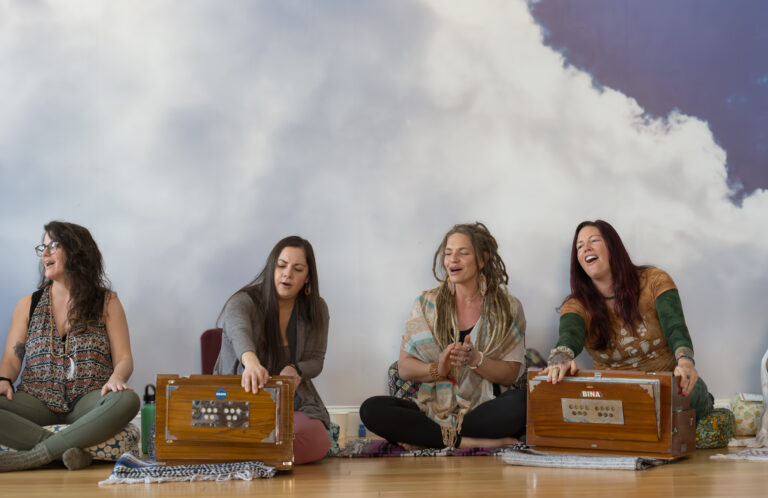
Kirtan in Ancient India and the Bhakti Yoga Tradition
Kirtan first flourished along the sacred rivers and villages of India. Welcoming everyone, no matter their background, Bhakti Yoga offered the path of loving devotion. Unlike more rigid, scholarly forms of spiritual practice, Bhakti Yoga simply asked people to feel, sing, and connect directly with the divine.
Old kirtans often praised deities like Krishna or Rama, drawing lyrics from timeless epics. These sessions weren’t about ceremony or perfection—they were about sincerity. With no barriers of caste or learning, kirtan gatherings let anyone participate, turning voices into collective prayer and dissolving social divides. Over time, kirtan became a joyful rebellion against complicated rituals and divisions, proving that spirituality could be as simple as gathering to sing with an open heart.
How Kirtan Spread to the West
The practice found its way to the West in the 1960s—a time when many were searching for deeper meaning. Spiritual leaders like A.C. Bhaktivedanta Swami Prabhupada played a crucial role, bringing kirtan to public spaces in New York City and inspiring curiosity and a sense of community through the power of repetition and music.
As the Hare Krishna movement grew, kirtan became its heartbeat, but soon spread beyond, embraced by yoga teachers and musicians influenced by time spent in India. By the 1970s and 1980s, kirtan was heard in yoga studios and wellness spaces, its popularity boosted by artists like Krishna Das and Deva Premal, who blended traditional mantras with Western sounds.
Ultimately, kirtan offered Western seekers something unique—a way to connect, belong, and experience unity, simply through singing together. This communal spirit led to its ongoing presence in Western yoga, music, and wellness communities today.
Call-and-Response Chanting Explained
At the heart of kirtan is the call-and-response format, a beautifully simple yet powerful structure. A leader sings a line—a mantra or phrase—and the group echoes it back. It’s a dialogue, a back-and-forth that builds energy with each repetition. You don’t need to know the words at first; the repetition makes it easy to catch on. There’s something primal about it, like a conversation that transcends language. It’s not uncommon to feel a shift as you chant—stress melting away, a sense of connection blooming with strangers who, for that moment, feel like family.
Instruments You’ll Hear in Kirtan (Harmonium, Drums, Cymbals & More)
The soundscape of kirtan is as inviting as the chanting itself. The harmonium, a small, portable reed organ, often leads the melody with its warm, droning tones, grounding the group in a steady hum. Drums like the tabla or mridangam bring a heartbeat to the music, their rhythms urging you to move or clap along. Hand cymbals, known as kartals, add a bright, shimmering layer, while other instruments—think guitars, flutes, or even a tambourine—might weave in depending on the group. It’s a living, breathing sound, often raw and unpolished, but that’s the charm. It’s not a performance; it’s a shared creation. A growing group of international professional musicians, deeply influenced by yoga, are also creating music that integrates traditional mantras and kirtan with instrumentation from a variety of cultures and genres.
The Role of Sanskrit Mantras
Central to kirtan are the mantras, often sung in Sanskrit, the ancient language of yoga and spiritual texts. These aren’t just random words—they’re believed to carry specific vibrations, each syllable resonating with a unique energy. Chanting “Om,” for instance, is said to connect you to the universal sound, while other mantras might invoke peace, love, or healing. You don’t need to understand Sanskrit to feel the effects; the sound itself does the work, bypassing the mind and speaking straight to the heart. It’s a practice of letting go—less about intellectualizing, more about immersing yourself in the moment.
Kirtan at Asheville Yoga Center, Kirtan in Daily Life
Kirtan isn’t just some ancient practice reserved for far-off ashrams or the deeply spiritual elite. It’s a living, breathing experience that can weave its way into your daily life, right here in the heart of the Blue Ridge Mountains. At this vibrant hub of yoga and community, kirtan sessions are a beloved heartbeat, pulsing with chants that range from soul-stirring to downright joyful.
Picture this: a room full of diverse folks from all walks of life sitting cross-legged or swaying on their feet, voices blending into a harmony that feels bigger than the sum of its parts. These gatherings aren’t about perfection; they’re about connection. You don’t need to know the words or hit the right notes. You just show up, open your heart, and let the sound carry you.
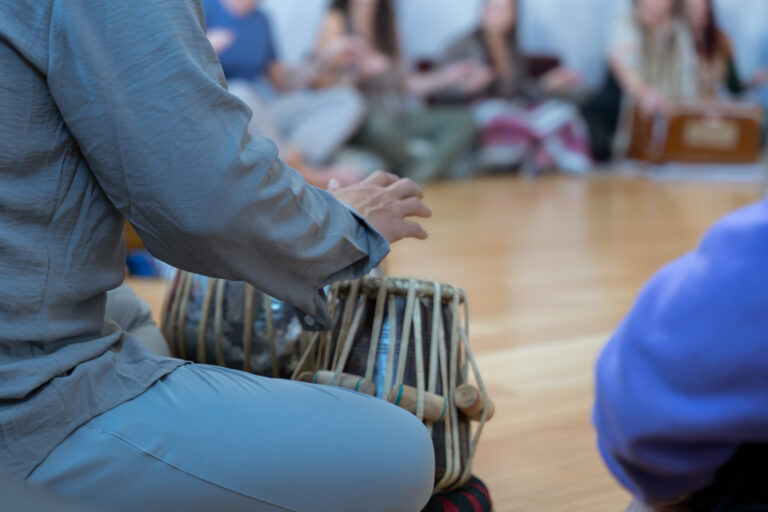
The Bigger Picture: Kirtan as a Gateway to Bhakti Yoga, How Music and Spirituality Intertwine
Let’s zoom out for a moment and look at kirtan not just as a standalone practice, but as a vibrant thread in the rich tapestry of yoga’s spiritual traditions. If you’ve ever felt a lump in your throat during a powerful song or been moved to tears by a melody that seems to speak directly to your soul, you’ve already glimpsed the essence of Bhakti. It’s about love, surrender, and connection to something greater than yourself, whether you call that the divine, the universe, or simply the shared human experience.
Here’s where music and spirituality intertwine in a way that feels almost magical. Music, after all, is a universal language. It transcends barriers of culture, age, and belief, hitting us on a primal level. When you chant in a kirtan circle, you’re not just singing—you’re tapping into a lineage of seekers who’ve used sound as a bridge to the sacred for centuries. The harmonium’s drone, the tabla’s pulse, the swell of voices: it’s a reminder that spirituality doesn’t have to be solitary or silent. It can be communal, and deeply human. Kirtan shows us that devotion isn’t about perfection; it’s about showing up, opening up, and letting the music carry you somewhere deeper.
Join the Sacred Sound of Kirtan at Asheville Yoga Center
If you’ve been curious about what is kirtan and are ready to dive into this transformative practice, there’s no better place to start than Asheville Yoga Center (AYC). Since 1997, AYC has been a beacon of heart-centered instruction, welcoming everyone—beginners, seasoned yogis, and wellness seekers alike—into a vibrant, inclusive community.
Our weekly classes, workshops, and events offer the perfect opportunity to experience kirtan firsthand, surrounded by a supportive tribe. Whether you’re chanting for the first time or deepening your practice, AYC’s down-to-earth teachers guide you with warmth and authenticity. Beyond kirtan, explore over 50 classes tailored to all levels, yoga teacher trainings, and workshops. Browse our unique boutique, or join us for retreats that nurture body and soul. At AYC, we’re not just about yoga; we’re about guiding you to fully engage with life. So, come as you are, raise your voice, and let the sacred sounds of kirtan resonate within. We can’t wait to welcome you to our family.
Frequently Asked Questions About Kirtan
Kirtan is a beautiful, soulful practice rooted in the yoga tradition, often described as a form of devotional chanting. The word “kirtan” comes from Sanskrit, meaning “to narrate, recite, or praise,” and it’s all about connecting with the divine through sound and song. At Asheville Yoga Center (AYC), we see kirtan as a way to open the heart, weaving together music, mantra, and community to create a shared experience of joy and reverence. It’s less about perfection and more about feeling the vibration of sacred sounds.
Yes, in a way, kirtan can absolutely be a meditative practice. While it’s more active than sitting silently with your eyes closed, the repetitive nature of chanting mantras helps quiet the mind and draw you into a state of presence. At AYC, we often describe it as a moving meditation—one where your voice, breath, and spirit align. Many participants find that the rhythmic call-and-response style of kirtan creates a deeply calming, almost trance-like state, connecting you to something bigger than yourself.
Not at all! You don’t need to speak or understand Sanskrit to dive into kirtan. Most sessions at Asheville Yoga Center are led by experienced facilitators who guide the group through simple, repetitive chants. You’ll often follow a call-and-response format, so you can just listen and echo what’s sung. Over time, the words and their vibrations become familiar, but the magic of kirtan lies in the feeling, not the translation. We’re all about making this accessible, so come as you are—no prior knowledge required.
You’ll likely sit in a circle or on the floor (chairs are available if needed), surrounded by a diverse group of folks—some regulars, some first-timers. A leader, often with a harmonium or guitar, starts with a simple chant, and the group joins in, responding in unison. Instruments like drums or tambourines might layer in, building energy. It’s casual yet powerful—some people sing loudly, others hum quietly, and a few just soak it in. Sessions can last an hour or two, often ending with a shared moment of silence or gratitude. It’s a heart-centered experience, and at AYC, we make sure everyone feels welcome.
Kirtan offers a treasure trove of benefits for mind, body, and soul. On a practical level, chanting can reduce stress by lowering cortisol levels and calming the nervous system—science backs this up. Emotionally, it’s a release, helping you process feelings through sound and connection. Spiritually, many find kirtan to be a doorway to inner peace, a way to tap into joy and unity. At Asheville Yoga Center, we’ve seen how kirtan builds community, too—there’s something profound about singing together, no matter your background. It’s empowering, healing, and often leaves you feeling lighter and more connected.
Absolutely, yes! Beginners are wholeheartedly welcome at AYC’s kirtan events. You don’t need any prior experience with yoga, chanting, or music to join in. Our community is inclusive and down-to-earth, and our facilitators are skilled at creating a safe, supportive space for everyone, whether you’re a first-timer or a seasoned practitioner. We’re here to guide you through the practice with warmth and encouragement, embodying our heart-centered approach to yoga. Just show up, sit down, and let the sound carry you—there’s no wrong way to participate.
